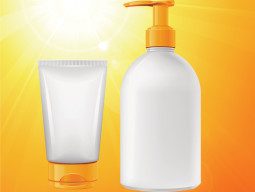
It’s summer time. The time when people head down to beaches and parks with friends; the time young boys and girls are out to have fun and, of course, the time when our precious skin is most vulnerable to the scorching sun. But in Pakistan, what summer really means is sweating, mood swings, tantrums, sunscreen and SPFs!
It’s a common notion that we should apply sunscreen not only in summer but also in winter — even when you are indoors, you should have sunblock on. But the question which has raised a lot of concern is: Are these creams depriving us of vitamin D? According to IANS, a new study indicates that the use of sunscreen affects the level of vitamin D in our bodies, depending on the quantity of sunscreen applied to the skin.
Studies have shown that sunscreen prevents the skin from burning and also lowers the risk of skin cancer. On a rather disappointing note, further studies have proven that these creams can actually stop your skin from producing the amount of vitamin D it really requires, reports dailymail.co.uk.
Antony Young, a professor of Experimental Photobiology at St John’s Institute of Dermatology, King’s College London, recruited 79 men and women — who were about to go on a week’s holiday — for an experiment.
Their vitamin D levels were checked and they were then asked to apply sunscreen from morning till evening. It was discovered that people didn’t apply the right amount of cream to reap benefits.

“You should use two milligrams of sun cream per centimetre of skin, but most people don’t do that. I have calculated that when people apply a factor 30 suncream, the way they put it on means they get the equivalent protection of a factor 4,” said Young.
“So we showed one group how to apply it and gave them a tube each day [of SPF 15] with the correct amount for them to apply. The other group was allowed to take their own suncream and apply it as they normally would.”
The results showed that even those, who used suncream in abundance, had a considerable increase in their vitamin D levels a week later.
“The group, who applied their own suncream, had an increase in vitamin D levels of 28 nml [nanomoles] per litre, but also had substantial sunburn,” said Young, whose study, part-funded by Boots, is due to be published this year.
However, people in the group, who had been taught how to apply suncream, had an increase of 16 nml per litre of blood, but they didn’t get any burns.
“That is still a significant rise in vitamin D levels,” he said.
Suncreams filter out UVB — the part of the sun’s rays that causes sunburn. However, UVB is also what stimulates our bodies to produce vitamin D.
Professor Young believes his results show that some UV will get through the suncream.
Dorothy Bennett, a professor of cellular biology at St George’s, University of London, argues that creams with a higher SPF might produce different findings. “However, this does show you can stay safe in the sun and still get enough vitamin D,” she said.
Published in The Express Tribune, June 12th, 2013.
Like Life & Style on Facebook, follow @ETLifeandStyle on Twitter for the latest in fashion, gossip and entertainment.
COMMENTS (1)
Comments are moderated and generally will be posted if they are on-topic and not abusive.
For more information, please see our Comments FAQ



































If you're concerned about vitamin D suppression due to sunscreens, Kabana Skin Care makes an SPF 35 sunscreen formula made with organic ingredients that supplements transdermal vitamin D - http://kabanaskincare.com/products/green-screen-d-organic-sunscreen-spf-35/ It has just 6 certified organic, mineral or vitamin ingredients. Excellent for children.